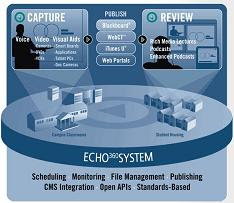
I finally had an opportunity to view Echo360 version 2.1, and it is clearly a very different product than Anystream's Apreso 1.3.x.
Gone is the distributed encoding architecture. The content manager is substantially improved, and it is designed to record via networked 'capture appliances'. The capture appliances produce H.264 video, which is then transcoded at the server before it can be viewed. The video is trascoded to Quicktime and the display graphics is transcoded to Flash Video (ie- FLV format). The H.264 is retained for editing. Audio MP3, eBook M4B and 'vodcast' (that's audio plus full motion presentation graphics) in M4V format are also output during transcoding.
The content manager is bundled with the Jetty (J2EE) web application server and the Derby database. It also comes with a Java-based Wowza Media Server (though you may use a licensed Flash Media Server if you prefer).
This new release is heavily server-centric, which could be fine for big institutions. But what about for a smaller campus or corporate use? My first impression is that it's going to be difficult to sell this product to any but the largest institutions.
As long as we're on first impressions, I've got to say that the new release has many plus points, including better integration of scheduling and content management (with scheduling now done at the server), better user and course administration (with more granular control of admin rights) and support for publishing to multiple LMS or CMS applications (you can actually publish the same recording into multiple courses). The user interface is certainly nicer, and works well in Mozilla browsers. The installation is easier, and licenses now require activation (which prevents piracy).
But I have some concerns about limitations of this release as well:
- standalone capture software is not supported (unless installed via the server)
- software-based capture does not support video recording (it can record audio and display graphics only)
- raw files are not viewable before transcoding (again limiting software-based capture)
These issues will be a barrier to customers who wish to trial the capture station software, or who don't need a server at the initial deployment phase. Although the server software is free, there are significant 'hidden' costs that will be incurred when deploying the server software, SSL certs, a media server and the media processors. Not to mention the need to buy capture station hardware to record video. These issues may even prevent 1.3.x customers from migrating to the new platform - they will be giving up the flexibility and recording capability they enjoy now.
However I understand that current customers may opt for phased migration. They can upgrade the server first, and still use 1.3.x capture stations. They can then add hardware appliance capture stations or wait for a release of the software only version which includes video support.
Also, there are some minor annoyances in this release:
- additional Win2003 server hardware and licenses are required for each 5 capture stations
(one of the key architectural benefits of the 1.3.x release was decentralised processing)
- product installation obscures the location of important files such as the database
- for each hour of content, approximately 30 minutes of transcoding is required after uploading
- software activation requires an Internet connection (not available in some settings)
- confidence in AV connections is not addressed; users must still make test recordings
- no support for Vista on the standalone capture software (XP Pro is end-of-life)
- no support for 3rd-party LMS and CMS software (currently Blackboard, WebCT and Moodle are supported)
- no support for mic inputs on the hardware-based capture station (ok, very minor)
Sadly, this release does not include viewer usage reports and presentation editing.
I think at the very least, Echo360 would need to provide for: (a) standalone capture station installation, (b) offline software activation just like Microsoft and Adobe, and (c) some utility which will convert recordings to a viewable format on the capture station. Without these capabilities, there can be no trial installations, no simple or small-enterprise deployments that don't include a server and no confidence-building display of test recordings. The need to connect to a server just to complete a test recording also means unnecessary complexity for laptop sales demos.
I also feel that intentionally crippling the capture station software to prevent video recording is a show-stopper. So Echo360 should provide: (d) a video license upgrade option for standalone capture stations.
 According to a report in Earthtimes, Echo360 has been named a "Visionary Vendor" in education technology by Basex, a leading knowledge economy research and advisory firm.
According to a report in Earthtimes, Echo360 has been named a "Visionary Vendor" in education technology by Basex, a leading knowledge economy research and advisory firm. 
